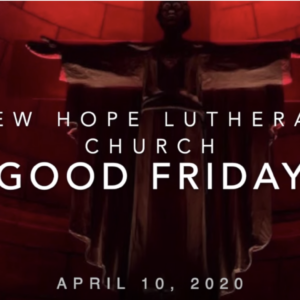John 18:1—19:42
The Passion of Our Lord Jesus Christ according to St. John
—————
Please pray with me tonight, church:
Holy and Crucified One,
Behold us, your children.
Fix our eyes on your suffering and anguish.
Strengthen us to behold your death,
That we might behold our life.
Amen.
—————
We have a tendency to avert our eyes.
We don’t like to look upon things that make us hurt. Or uncomfortable. Or uneasy. Or nauseous.
We don’t like to look upon pain. Especially if it’s pain that we may have had a role in causing.
We see hurt and pain all around us, maybe especially more so in this time of pandemic. We see news reports and pictures and videos of death…of hospitals being overrun…testing sites being slammed beyond capacity…ventilators on their last legs…masks and goggles and face shields getting reused…nurses and doctors and surgeons trudging through halls barely able to stand…
Oh Lord, we know pain this year…
We know fear…and hurt…and anxiety…and worry…
The Great Three Days…the Triduum…Maundy Thursday, Good Friday, and the Easter Vigil…invite us deeply into the betrayal, suffering, death…and too, the resurrection of Jesus. These Three Days implore us to look…or maybe more appropriately, one of my favorite biblical words, to behold.
The last words in our service tonight beg us to that same reflection: “Behold, the life-giving cross, on which was hung the Savior of the whole world.”
It is in looking upon the pain and suffering of Christ, in not averting our gaze, that we begin to understand within our innermost self…at our most cellular level…the pain, suffering, hurt, injustice, and brokenness that Christ died in order to overcome.
Don’t look away. Don’t avert your eyes.
Behold…the life-giving cross.
I mentioned yesterday that all of the incredibly profound stories we hear throughout Holy Week beg the question of us: What does Love look like?
Last night we heard of a self-giving love that takes the lower place and washes the feet of those who are beneath them.
Tonight, we hear of a self-giving love that suffers death so that you would have life.
Tonight, we hear of a self-giving love that dies. A love that dies…for you.
Lutheran pastor and great theologian Gerhard Forde said that “Jesus doesn’t die instead of us…Jesus dies in our stead.” Jesus doesn’t die in place of us…Jesus dies in our place…that is, the place where we all die. Church, Jesus doesn’t take our place as a recipient of God’s wrath against our sinfulness…our sin is crucified with Jesus to show us that not even our sinful rebellion against God is a barrier to our being in the right relationship with God.
As a Lutheran pastor and theologian Nadia Bolz-Weber notes, “The message of Good Friday is that God would rather die, than to be in the sin-accounting business anymore.”
Look upon the cross.
Behold your sin taken upon Christ’s own self and crucified.
Behold your salvation.
Love looks like God dying.
The cross was where enemies of the state were executed. The cross was a highly visible reminder to everyone exactly who was in the dominant position of power and what would happen if you tried to subvert the established rule of “the way things are.”
Love looks like God’s solidarity with those who die. Those who die unjustly. Those who have been falsely accused. Those that have been called “treasonous,” “seditious,” “trouble-makers,” “rabble-rousers,” “enemies of the state,” or any other manner of nasty words.
The crucifixion and death of Christ demonstrate completely God’s solidarity with those that are dying and those that are executed for pointing out the ways that the “way things are” disproportionately harm the vulnerable and marginalized populations and those who are on the underside.
The cross is God’s ultimate act of solidarity with the ones who are hurting, injured, in pain, fearful, worried, and anxious.
The cross is God’s ultimate act of solidarity with the marginalized and the oppressed.
The cross is God’s ultimate act of solidarity with those who are dying…with those who have a positive diagnosis.
The cross is God’s ultimate act of solidarity with the sick and the immuno-compromised.
The cross is God’s ultimate act of solidarity with humanity.
This is what love looks like.
Love looks like God dying.
And…in that glorious paradox that is somehow always true with God…the Lutheran understanding of a theology of the cross asserts that God is somehow most present…where God appears to be most absent.
It is in the suffering and death and dying…that God brings forth life.
Out of pain and hurt and suffering, God brings healing and restoration and wholeness.
Out of your pain and hurt and suffering, through the cross of Christ, God dares to bring healing and restoration and wholeness.
God would die before God would let you remain in bondage to your sin—to the ways in which you separate yourself from God and from your neighbor, from the stranger, from the other.
God takes what is intended for destruction, and uses it for salvation.
God takes what is meant for execution, and uses it for resurrection.
God transforms the means of death into the means of life.
Behold…the cross.
Behold…life given for you.
Behold…your salvation.
Behold…love.
Behold.
The life-giving cross.
On which was hung the Savior.
Of the whole world.

